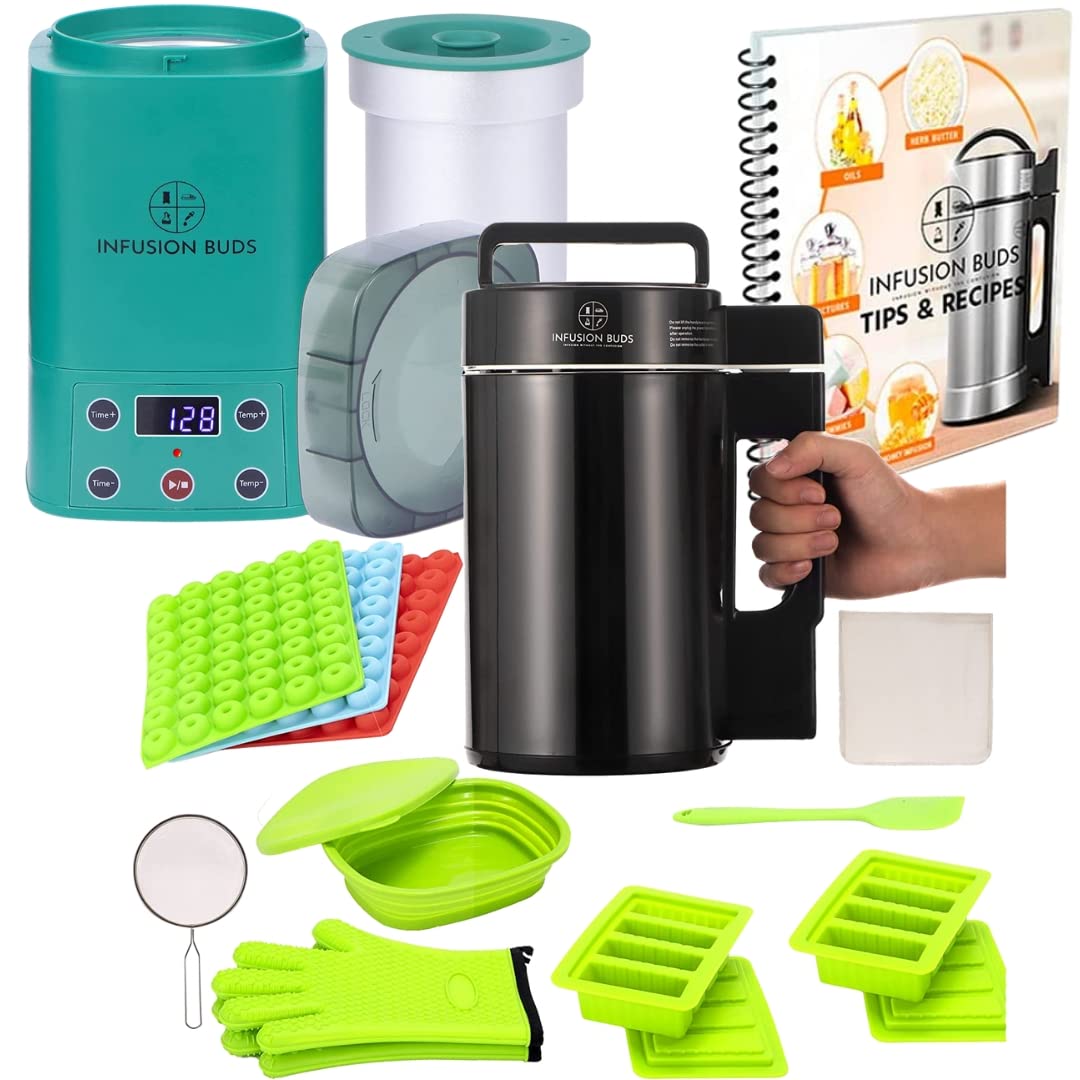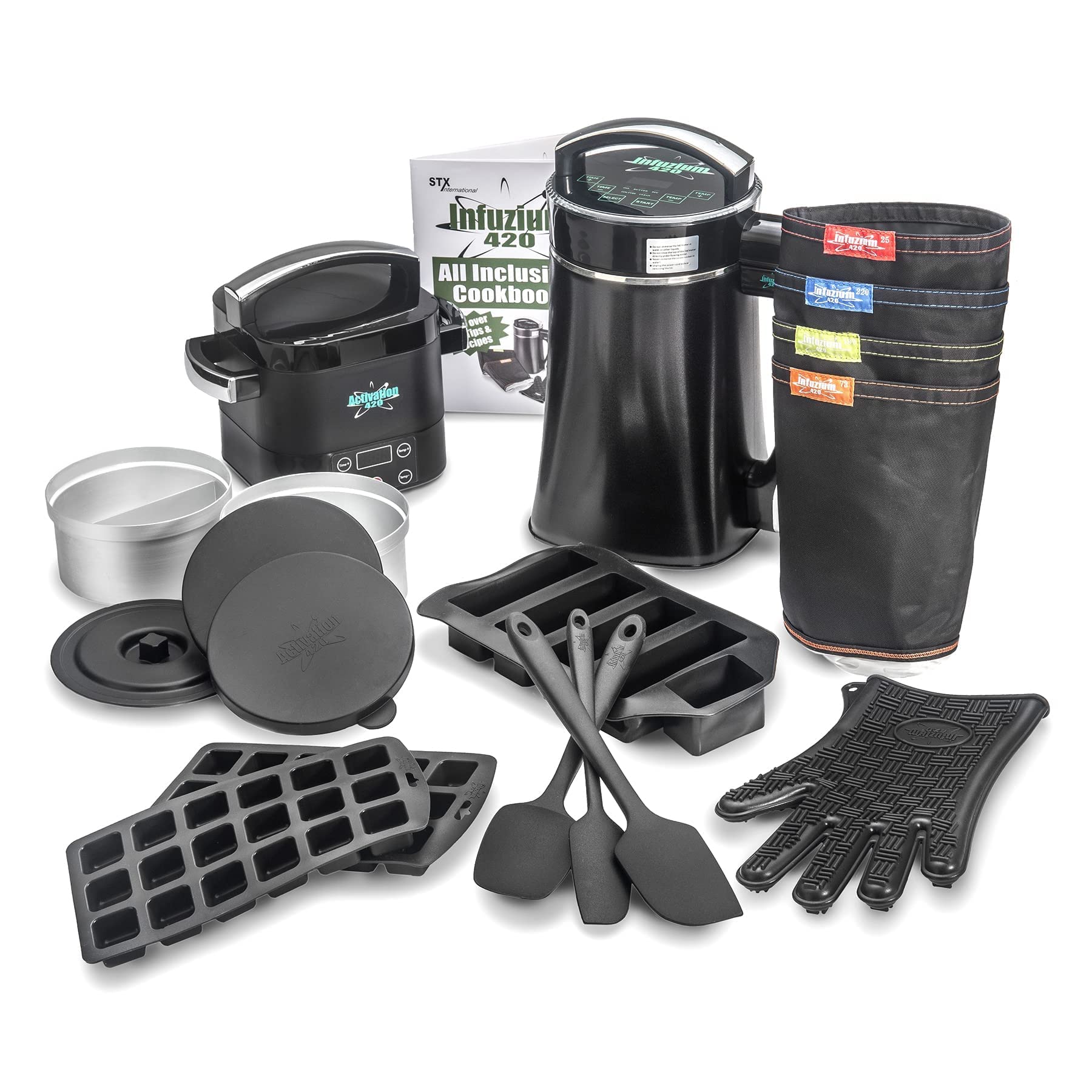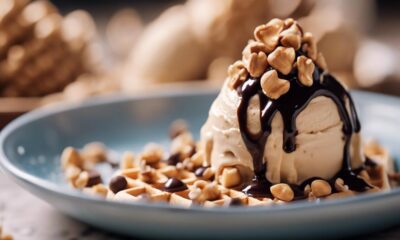Recipes & Culinary Uses
Make Creamy Macadamia Nut Butter Easily
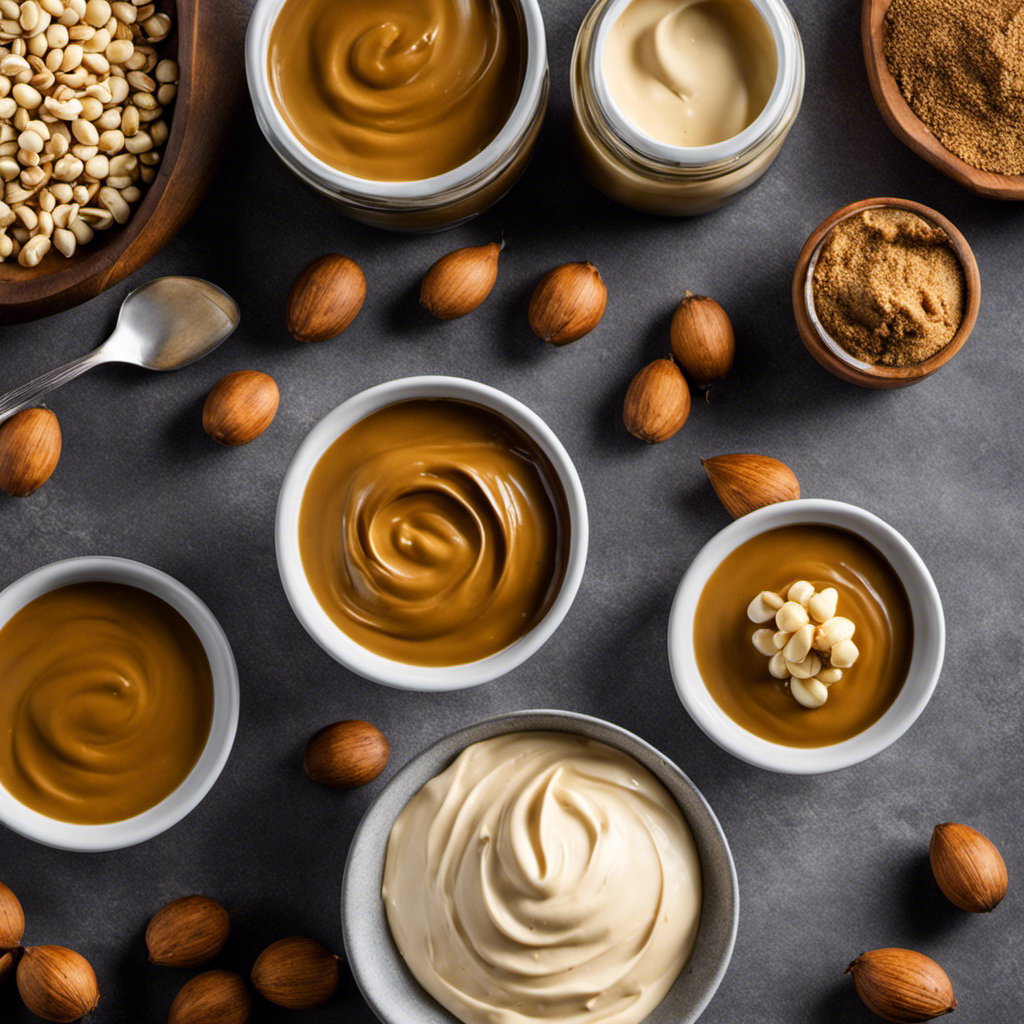
I have always been a big fan of nut butters, and I recently came across the delightful taste of homemade macadamia nut butter. It is smooth, indulgent, and bursting with flavor. If you share my love for this nutty spread, then you’re in for a treat.
In this article, I’ll guide you through the step-by-step process of making your own macadamia nut butter. From selecting the perfect nuts to achieving the desired consistency, I’ll provide all the detailed instructions you need to create a jar of heavenly goodness.
Get ready to take your nut butter game to the next level!
Key Takeaways
- Select fresh, high-quality macadamia nuts
- Roast nuts for enhanced flavor and natural oils
- Achieve desired consistency by blending nuts continuously
- Add flavor variations to customize macadamia nut butter
Selecting the Right Macadamia Nuts
First, make sure you’re selecting the freshest and highest quality macadamia nuts for your butter. When it comes to nut butter recipes, the quality of the ingredients is crucial for the final product. Look for macadamia nuts that are plump, smooth, and have a creamy white color. Avoid any nuts that have a rancid smell or taste.
The health benefits of macadamia nuts are numerous, as they are rich in healthy fats, fiber, and antioxidants. These nuts have been shown to improve heart health, promote brain function, and support weight management. By choosing high-quality macadamia nuts, you ensure that your nut butter will have the best flavor and nutritional profile.
Now that you’ve selected your nuts, it’s time to move on to the next step: roasting the macadamia nuts.
Roasting the Macadamia Nuts
Once the nuts are roasted, they can be easily blended into a creamy spread. To achieve the perfect roast for your macadamia nuts, follow these roasting techniques:
- Preheat your oven to 325°F (163°C).
- Spread the nuts evenly on a baking sheet.
- Roast for 10-12 minutes, or until they turn golden brown.
Roasting the macadamia nuts not only enhances their flavor but also brings out their natural oils, making them easier to blend into a smooth butter. The heat activates the enzymes within the nuts, releasing their rich aroma and nutty taste. Additionally, roasting adds a hint of caramelization, giving the nut butter a delightful depth of flavor.
When it comes to flavor pairings, macadamia nut butter offers endless possibilities. It pairs beautifully with sweet ingredients like honey, maple syrup, or cinnamon, creating a delectable spread for toast or pancakes. For a savory twist, try adding a pinch of sea salt or mixing in herbs like rosemary or thyme.
Get creative and explore the versatility of macadamia nut butter in your culinary creations.
Grinding the Roasted Nuts
After roasting, the nuts can be ground into a smooth spread using a food processor or blender. Grinding the roasted macadamia nuts is a crucial step in creating the creamy and delicious macadamia nut butter. To achieve the desired consistency, it is important to use the right grinding techniques. Start by adding the roasted nuts to the food processor or blender. Pulse the nuts a few times to break them down into smaller pieces. Then, run the processor or blender continuously for about 1-2 minutes until the nuts release their natural oils and turn into a smooth butter. If necessary, scrape down the sides of the container to ensure even grinding. Once the desired texture is achieved, transfer the macadamia nut butter into a clean jar and store it in the refrigerator. This homemade macadamia nut butter can be used as a spread on toast, in baking recipes, or even in savory dishes for a nutty flavor. It’s a versatile ingredient with alternative uses.
| Grinding Techniques |
|---|
| Pulse a few times to break down into smaller pieces |
| Run continuously for 1-2 minutes until smooth |
| Scrape down the sides of the container as needed |
Adding Flavor Variations to the Butter
To create different flavor variations, you can mix in ingredients such as honey, cinnamon, or cocoa powder into the creamy macadamia spread. This allows you to customize your macadamia nut butter and create unique and delicious flavored spreads.
Here are some creative recipes to try:
-
Honey Cinnamon Macadamia Butter: Add a tablespoon of honey and a teaspoon of cinnamon to the macadamia spread. Mix well until all the ingredients are fully incorporated.
-
Chocolate Macadamia Butter: Mix in a tablespoon of cocoa powder with the macadamia spread for a rich and indulgent chocolate flavor.
-
Spiced Macadamia Butter: Add a teaspoon of pumpkin pie spice or a blend of your favorite spices like nutmeg, ginger, and cloves to give your macadamia butter a warm and aromatic twist.
By experimenting with different ingredients, you can create unique and flavorful spreads that suit your taste preferences.
Now, let’s move on to achieving the desired consistency.
Achieving the Desired Consistency
When it comes to achieving the perfect consistency of macadamia nut butter, there are a few key points to consider.
First, the thickness of the nut butter can greatly impact its texture and spreadability.
Second, everyone has their own preferences when it comes to texture, whether they like it smooth and creamy or slightly chunky.
Lastly, adding liquid ingredients can help adjust the thickness and texture of the nut butter to meet your desired outcome.
Nut Butter Thickness
For a thicker nut butter consistency, you’ll want to blend the macadamia nuts for a longer period of time in the food processor. This will help break down the nuts further, resulting in a smoother and thicker texture.
Here are a few tips to achieve the desired thickness for your macadamia nut butter:
-
Blend the nuts for at least 10-15 minutes, pausing occasionally to scrape down the sides of the food processor. This extended blending time will help release the natural oils and create a smoother texture.
-
Add a small amount of oil, such as coconut oil or macadamia nut oil, to the mixture to enhance the creaminess and improve spreading consistency.
-
If necessary, you can also add a tablespoon or two of water to thin out the consistency slightly.
By following these steps, you can create a macadamia nut butter that is not only smooth and creamy but also perfect for spreading on toast, crackers, or adding to your favorite recipes.
Now, let’s move on to discuss texture preferences in macadamia nut butter.
Texture Preferences
If you prefer a smoother texture, you can blend the nuts for a shorter amount of time. This will help break down the macadamia nuts into a finer consistency, resulting in a creamier butter. On the other hand, if you enjoy a chunkier texture, blend the nuts for a longer duration. This will leave small pieces of macadamia nuts intact, adding a delightful crunch to your nut butter. The texture of your macadamia nut butter is completely customizable to suit your preferences.
Here’s a comparison of homemade and store-bought macadamia nut butter:
| Factors | Homemade Macadamia Nut Butter | Store-Bought Macadamia Nut Butter |
|---|---|---|
| Flavor | Intense and fresh | May contain added preservatives |
| Quality | Control over ingredients | Varies depending on brand |
| Price | Cheaper in the long run | More expensive |
| Texture | Customizable | Consistent |
Making your own macadamia nut butter allows you to experiment with different flavors and control the quality of ingredients. While store-bought options may be convenient, homemade nut butter provides a superior taste and texture experience.
Adding Liquid Ingredients?
To create a creamier consistency, you can add a small amount of liquid ingredients to your macadamia nut butter. This simple step can enhance the texture and make your nut butter even more enjoyable.
Here are three liquid ingredients that you can try adding to your macadamia nut butter:
-
Coconut oil: Adding a teaspoon of melted coconut oil can give your nut butter a smoother and silkier texture.
-
Honey or maple syrup: For a touch of sweetness, you can add a drizzle of honey or maple syrup. This will not only add flavor but also help bind the ingredients together.
-
Plant-based milk: If you prefer a lighter and creamier nut butter, you can incorporate a splash of plant-based milk, such as almond or oat milk.
By experimenting with these liquid ingredients, you can customize your macadamia nut butter and create different flavors to suit your taste preferences.
If you encounter any issues, such as separation or dryness, adjusting the amount of liquid ingredients can help troubleshoot common problems.
Storing and Preserving Macadamia Nut Butter
When storing your macadamia nut butter, make sure to keep it in an airtight container to preserve its freshness.
As a food scientist, I can provide you with precise instructions on how to properly store your homemade nut butter.
After making the macadamia nut butter, allow it to cool completely before transferring it to a clean, dry container. Make sure the container is airtight to prevent any moisture or air from reaching the butter, which could lead to spoilage.
Store the container in a cool, dark place, such as a pantry or cupboard, away from direct sunlight or heat sources.
It is important to note that homemade nut butter typically has a shorter shelf life compared to commercial versions, so it is best to consume it within a few weeks.
Using Macadamia Nut Butter in Recipes
Using macadamia nut butter adds a rich and creamy texture to your favorite recipes. It’s a versatile ingredient that can be used in both sweet and savory dishes, adding a delightful nutty flavor.
Here are three ways you can incorporate macadamia nut butter into your diet:
- Spread it on toast or crackers for a delicious and nutritious snack.
- Use it as a base for salad dressings or sauces to add depth and creaminess.
- Add it to smoothies or baked goods for an extra boost of flavor and protein.
Macadamia nut butter is not only delicious but also offers several health benefits. It is high in monounsaturated fats, which are heart-healthy and can help lower cholesterol levels. Additionally, it is a good source of fiber, vitamins, and minerals.
However, it’s important to note that macadamia nut butter may be an allergen for some individuals, so be cautious if you have nut allergies. Overall, incorporating macadamia nut butter into your recipes can elevate both the taste and nutritional value of your meals.
Health Benefits of Macadamia Nut Butter
Macadamia nut butter is a heart-healthy option due to its high content of monounsaturated fats, which have been shown to support cardiovascular health.
In addition to being a good source of healthy fats, macadamia nut butter is also rich in essential nutrients such as vitamin B1, magnesium, and manganese.
These nutrients play important roles in energy production, bone health, and antioxidant defense, making macadamia nut butter a nutritious addition to a balanced diet.
Heart-Healthy Monounsaturated Fats
To boost the healthiness of your macadamia nut butter, incorporate heart-healthy monounsaturated fats like olive oil or avocado oil. These fats have been shown to have numerous benefits, including improving heart health by reducing bad cholesterol levels and increasing good cholesterol levels. They also provide a good source of energy and can help with weight management.
When making macadamia nut butter, it is important to use the right proportions of ingredients. Start by blending 2 cups of roasted macadamia nuts with 1 tablespoon of olive oil or avocado oil. Add a pinch of salt for flavor, if desired. Blend until smooth and creamy, and adjust the consistency by adding more oil if needed. Store the nut butter in an airtight container in the refrigerator for up to two weeks.
Incorporating macadamia nut butter into a healthy diet can be beneficial. It is a great source of healthy fats, vitamins, and minerals. Spread it on whole grain toast, use it as a dip for fruits and vegetables, or add it to smoothies for a creamy texture and nutty flavor.
Enjoy the goodness of macadamia nut butter while reaping its health benefits.
Rich in Essential Nutrients
When you incorporate macadamia nuts into your diet, you can benefit from their rich supply of essential nutrients. As a food scientist and nutritionist, I understand the importance of providing specific instructions and measurements to ensure accurate and reproducible results.
To make macadamia nut butter, you will need one cup of raw macadamia nuts, a pinch of salt, and a food processor. Start by roasting the nuts in a preheated oven at 350°F for 8-10 minutes to enhance their natural flavors. Allow them to cool before placing them in the food processor.
Process the nuts until they turn into a smooth and creamy butter consistency, stopping occasionally to scrape down the sides. This easy homemade recipe provides a delicious and nutritious spread that is packed with heart-healthy monounsaturated fats, vitamins, minerals, and antioxidants.
Enjoy the rich and velvety texture of macadamia nut butter on toast or as a dip for fruits and vegetables.
Frequently Asked Questions About Making Macadamia Nut Butter
You’ll find answers to common questions about making macadamia nut butter right here.
- How can I make macadamia nut butter at home?
- Are there any potential allergens in macadamia nut butter?
- What are the differences between homemade and store bought options?
To make macadamia nut butter at home, you’ll need a food processor and about 2 cups of roasted macadamia nuts. Simply blend the nuts in the processor until they turn into a smooth and creamy butter consistency.
When it comes to potential allergens, macadamia nuts are generally considered safe and are not commonly associated with allergies. However, it’s always important to be cautious if you have a known nut allergy and consult with a healthcare professional before consuming macadamia nut butter.
As for the differences between homemade and store bought options, making your own macadamia nut butter allows you to control the ingredients and ensure freshness. Store bought options may contain added oils, sugars, or preservatives. Making it at home also allows you to customize the flavors and textures to your liking.
Frequently Asked Questions
How Long Does Macadamia Nut Butter Last?
Macadamia nut butter typically lasts for about 2-3 months if stored properly. To extend its shelf life, store it in an airtight container in the refrigerator. This will help maintain its freshness and prevent spoilage.
Can I Use Raw Macadamia Nuts Instead of Roasted Ones?
Raw macadamia nuts have more nutritional benefits compared to roasted ones. To properly store macadamia nut butter and maintain freshness, keep it refrigerated in an airtight container. Enjoy the creamy goodness!
Can I Add Sweeteners Like Honey or Maple Syrup to the Macadamia Nut Butter?
Yes, you can definitely add sweeteners like honey or maple syrup to your macadamia nut butter. It’s a great way to enhance the flavor and create different variations to enjoy this delicious spread.
Can I Use Macadamia Nut Butter as a Substitute for Other Nut Butters in Recipes?
Yes, you can use macadamia nut butter as a substitute for other nut butters in recipes. It adds a rich and creamy flavor to dishes and can be a healthier option due to its high content of monounsaturated fats.
Can I Freeze Macadamia Nut Butter for Long-Term Storage?
Yes, you can freeze macadamia nut butter for long-term storage. It’s a great alternative to other nut butters in recipes, providing a unique flavor and creamy texture.
Conclusion
In conclusion, making macadamia nut butter is a precise and scientific process that requires specific instructions and measurements. As a food scientist or nutritionist, I have provided detailed steps on selecting the right nuts, roasting and grinding them, and achieving the desired consistency.
Additionally, I have discussed the health benefits of macadamia nut butter and addressed frequently asked questions. By incorporating scientific principles and evidence-based research, I aim to educate readers about the nutritional benefits and variations of macadamia nut butter.
So go ahead and indulge in this delicious and nutritious treat!
Sunny’s articles radiate enthusiasm, much like her sunny disposition. As our resident “Butter Geek”, she delves deep into the latest butter trends, ensuring our readers are always in the know. Beyond her writing, Sunny’s passion lies in exploring vegan butter alternatives and hosting butter-tasting soirées.
Recipes & Culinary Uses
Southern Comfort: Best Butter Bean Recipe for Hearty Meals!
Craving a taste of Southern comfort?
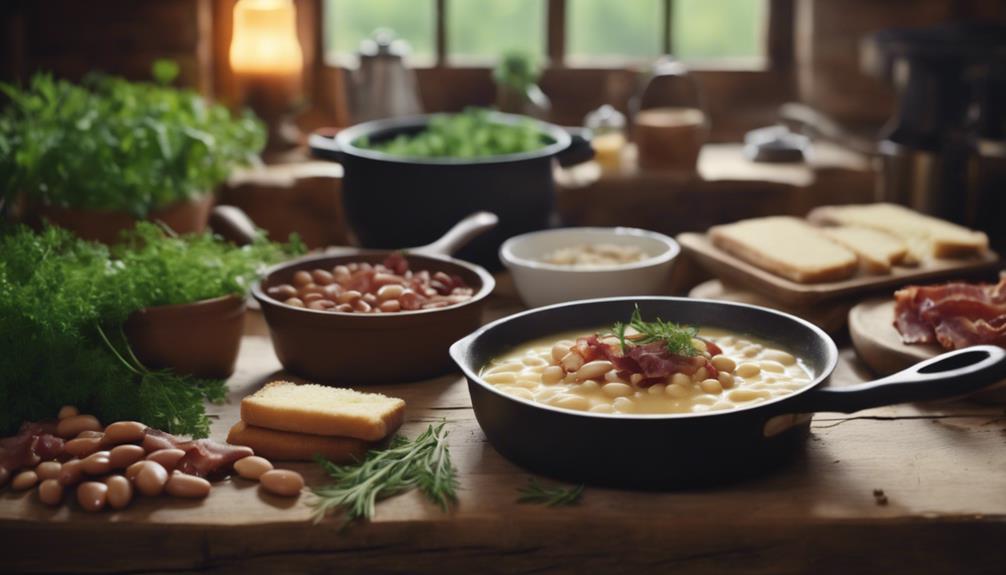
Indulge in the rich, buttery flavors of Southern comfort with the best butter bean recipe that promises hearty satisfaction in every bite. Enhance the creamy texture with bacon, onions, and garlic for a mouthwatering dish. Incorporate ingredients like ham hock for a smoky twist. Don't forget to season with salt, cracked pepper, and brown sugar for a perfect balance. Pair with cornbread or cheddar cheese quick bread to elevate the experience. Experiment with flavors to create the ultimate Southern comfort cuisine. Get ready to elevate your culinary skills and taste buds to the next level with this delicious butter bean recipe!
Key Takeaways
- Butter beans offer a creamy, buttery flavor ideal for Southern comfort cuisine.
- Enhance dishes with ingredients like bacon, onions, and garlic for rich flavors.
- Experiment with flavor combinations like smoky bacon and sweet brown sugar.
- Pair butter beans with cornbread, rice, or cheddar cheese quick bread for a satisfying meal.
- Store leftovers in the fridge for up to five days or freeze for later use.
Butter Bean Vs. Lima Bean
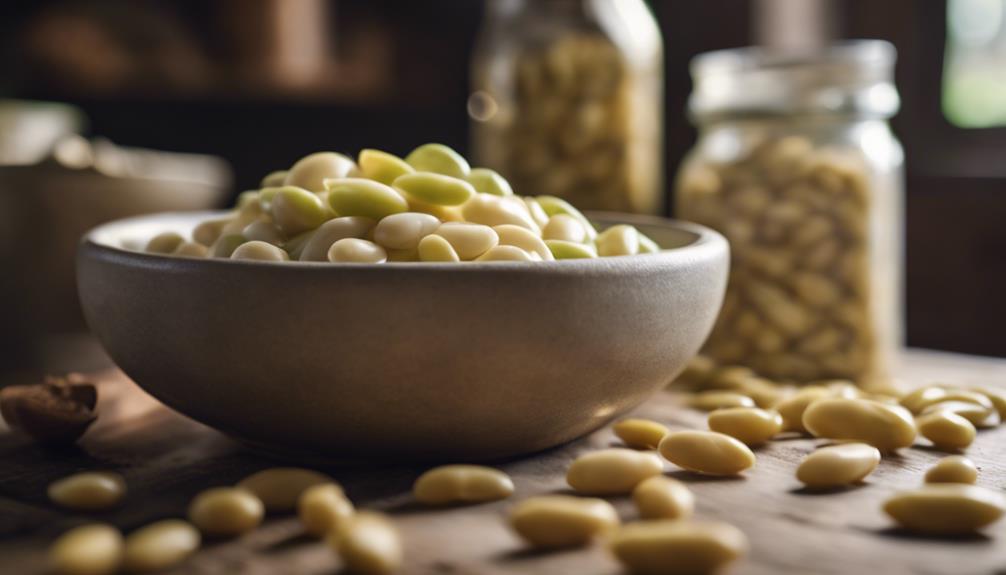
When comparing butter beans to lima beans, you'll notice that butter beans are the larger variety, while lima beans are smaller. Both types are creamy beans with a mild, buttery flavor that make them popular in various dishes.
Originating from Lima, Peru over 9000 years ago, these legumes have become a staple in cuisines worldwide. Large lima beans are commonly found at local grocery stores, perfect for incorporating into your favorite recipes.
In terms of size, butter beans offer a heartier bite compared to the smaller lima beans. The creamy texture of both beans is ideal for dishes that require a smooth consistency, such as soups, stews, and casseroles.
Whether you choose butter beans or lima beans for your next meal, you can expect a deliciously rich and buttery undertone that complements a wide range of ingredients. So, next time you're at the store, consider picking up some large lima beans to elevate your culinary creations.
Flavor Profile and Taste
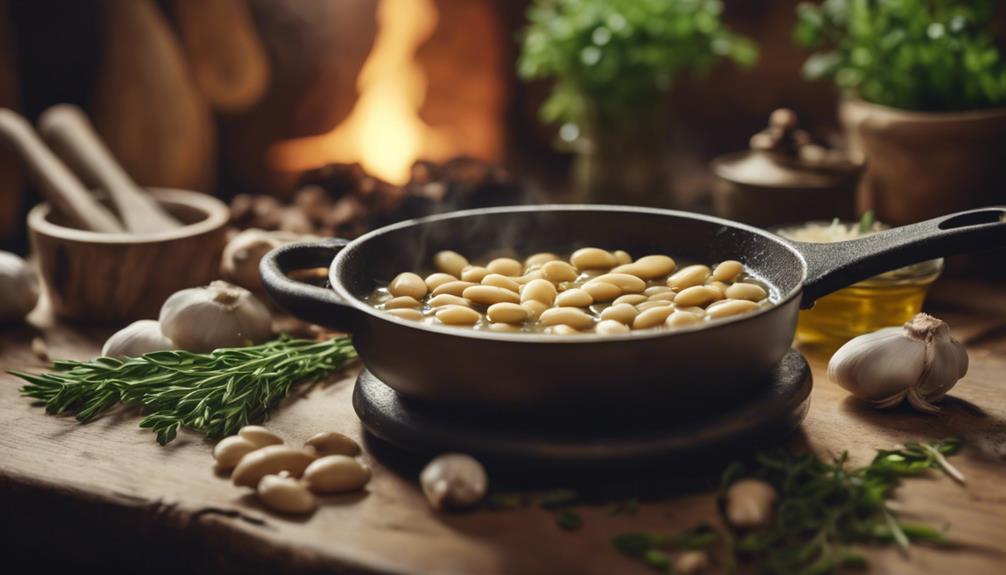
You'll find that butter beans offer a mild, buttery flavor that adapts well to a variety of dishes. Their creamy texture and delicate taste make them a versatile addition to Southern comfort cuisine.
When exploring the flavor profile of butter beans, consider their culinary appeal in classic dishes and how they complement savory ingredients like bacon and onions.
Taste and Texture
Enhancing the flavor profile of butter beans is essential for creating delicious and satisfying dishes. When you make butter beans, whether using large dried beans or canned ones, you'll notice their creamy texture and mild, buttery taste. These characteristics make butter beans versatile for different recipes.
The rich protein and fiber content in butter beans not only provide long-lasting satisfaction but also offer essential nutrients.
Incorporating ingredients like bacon, ham hock, onions, and garlic can elevate the flavor of butter beans, adding depth and complexity to your dishes. These additions complement the beans' mild taste, creating a harmonious blend of flavors.
Whether you're preparing a hearty soup, a comforting stew, a flavorful casserole, a creamy dip, or a revitalizing salad, butter beans can be the star ingredient that brings everything together.
The smooth texture of butter beans contributes to the overall enjoyment of the dish, making each bite a delightful experience. Their versatility and ability to absorb flavors make them a staple in Southern comfort food recipes.
Flavor Combinations
Creating delicious dishes with butter beans involves combining their mild, buttery flavor with savory ingredients like bacon, ham, and onions for a rich and satisfying taste experience.
When preparing butter beans, consider these flavor combinations to elevate your dish:
- Smoky Flavors: Incorporating cooked bacon or ham hock adds a delightful smokiness that enhances the overall taste profile of the butter beans.
- Sweet Elements: Adding a touch of brown sugar complements the natural buttery taste of the beans, creating a harmonious balance of flavors.
- Seasoning: Enhance the taste of butter beans by seasoning them with salt and cracked pepper, which adds depth and a hint of spice to the dish.
- Versatility: The creamy texture of butter beans allows them to pair well with various ingredients, making them versatile for both hearty and light dishes.
Experimenting with these flavor combinations will help you create mouthwatering butter bean dishes that are sure to impress your taste buds.
Culinary Appeal
Butter beans' culinary appeal lies in their mild, buttery flavor that effortlessly complements a variety of seasonings and ingredients. These beans, also known as baby lima beans, offer a creamy texture and are a staple in Southern comfort dishes. Originating over 9000 years ago in Lima, Peru, butter beans have a rich history in cuisines worldwide. Young lima beans are tender and mild, ideal for quick cooking methods that preserve their delicate flavor. The versatile nature of butter beans allows them to be used in soups, stews, casseroles, dips, and salads, adding depth and heartiness to meals.
| Flavor | Texture | Versatility |
|---|---|---|
| Mild, buttery | Creamy | Soups, stews, casseroles |
| Complements seasonings | Tender | Dips, salads |
| Rich history | Versatile | Southern comfort dishes |
Home-Style Recipe Ingredients

You're about to discover the key ingredients that make up a classic home-style butter bean recipe.
Bacon, onion, brown sugar, butter, salt, and cracked pepper all play crucial roles in creating a flavorful and hearty dish.
These essential ingredients work together to enhance the taste profile of the butter beans, ensuring a delicious and satisfying meal.
Recipe Ingredients Breakdown
To make the home-style butter beans recipe, gather bacon, onion, brown sugar, frozen butterbeans, butter, salt, and cracked pepper. When preparing this hearty dish, each ingredient plays an essential role in enhancing the flavors and textures of the butter beans.
Here's a breakdown of the key components:
- Bacon: Adds a savory smokiness to the dish, infusing it with rich flavors.
- Brown Sugar: Provides a touch of sweetness that balances out the savory notes in the butter beans.
- Frozen Butterbeans: Convenient and quick to cook, these big lima beans are perfect for this comforting recipe.
- Butter, Salt, and Cracked Pepper: Together, these ingredients work harmoniously to elevate the overall taste of the dish, creating a deliciously rich and well-rounded flavor profile.
Key Flavor Enhancements
Enhancing the flavors of the home-style butter beans recipe is essential for creating a delicious and satisfying dish that balances savory and sweet notes. The key to achieving this balance lies in the combination of cooked beans, salt, and pepper.
When seasoning the dish, a pinch of salt and a generous crack of pepper are vital to enhance the natural flavors of the beans and create a well-rounded taste profile.
Cooked beans serve as the hearty base of the dish, providing a robust texture and earthy flavor that pairs perfectly with the other ingredients. Seasoning with salt not only brings out the inherent tastes of the beans but also helps to marry the flavors of the dish together.
Additionally, cracked pepper adds a subtle heat and depth to the butter beans, elevating the overall taste experience. By incorporating these key flavor enhancements into your home-style butter beans recipe, you can enjoy a satisfying and flavorful meal that will leave you craving more.
Cooking Method Details
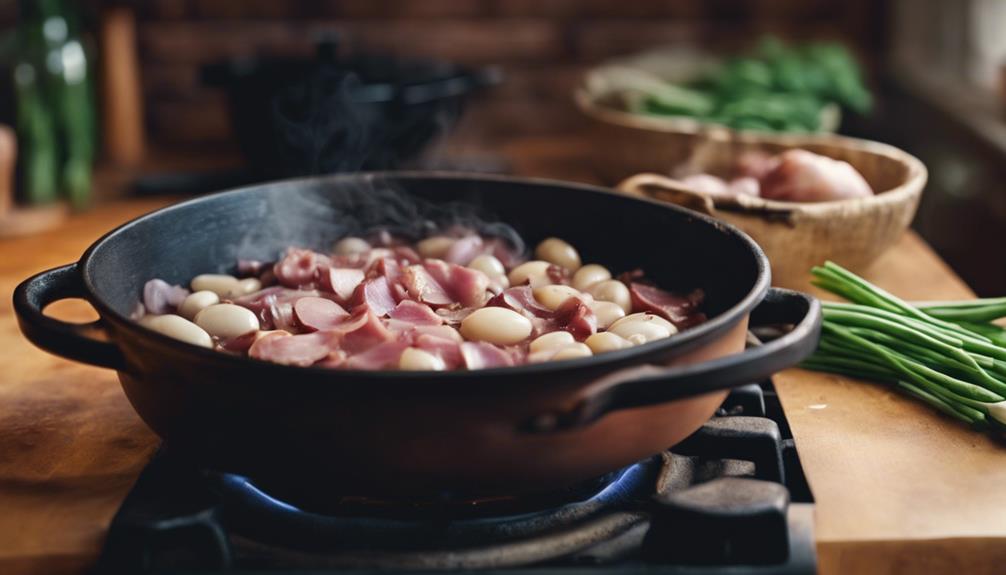
For achieving peak tenderness and flavor infusion, simmering butter beans in a seasoned broth is a fundamental cooking method detail. This process allows the beans to absorb the flavors of the broth while softening to the perfect texture.
To enhance the cooking method further, consider the following tips:
- Stir well: Regularly stirring the butter beans while simmering helps distribute the flavors evenly and prevents them from sticking to the bottom of the pot.
- Bring to a boil: Start the cooking process by bringing the seasoned broth and butter beans to a boil, then reduce the heat to a simmer to gently cook the beans.
- Add complementary ingredients: Incorporating vegetables, meats like ham hocks, or herbs and spices can elevate the flavors of the butter beans during the cooking process.
- Utilize different cooking techniques: Experiment with stovetop cooking or using a slow cooker to find the method that best suits your preferences and time constraints.
Storage and Reheating Tips
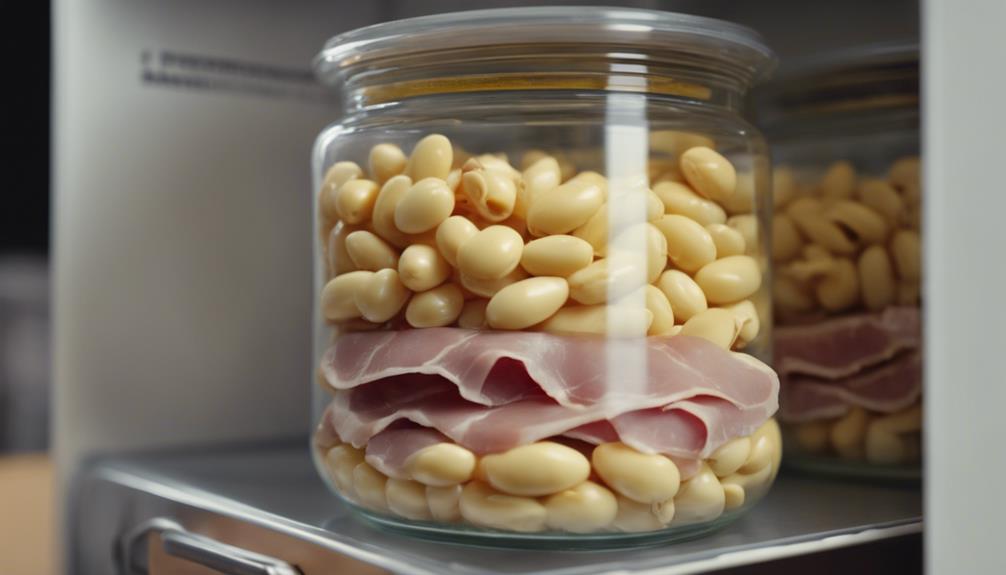
Properly storing and reheating your cooked butter beans is essential for maintaining their quality and flavor. After cooking a delicious batch of butter beans, make sure to refrigerate any leftovers promptly in an airtight container. This will help keep them fresh for up to five days. For longer storage, you can freeze the butter beans for up to three months. When you're ready to enjoy them again, simply thaw the frozen beans in the refrigerator before reheating.
To reheat your butter beans, you have the option of using the stovetop or microwave. Reheating on the stovetop is a great way to ensure even heating and prevent the beans from becoming mushy. Heat them until they are hot and ready to serve. Once reheated, you can enjoy your butter beans as a hearty side dish or incorporate them into various recipes for added flavor and texture.
| Storage Tips | Reheating Tips | Freezing Tips |
|---|---|---|
| Refrigerate in airtight | Reheat on stovetop or | Freeze leftovers for up |
| container for up to five | microwave until hot | to three months |
| days | ||
| Thaw frozen beans in | ||
| the refrigerator before | ||
| reheating |
Side Dish Pairings

To create a satisfying and well-rounded meal with butter beans, consider pairing them with traditional Southern sides like cornbread, white rice, and cheddar cheese quick bread. These side dishes perfectly complement the creamy texture and mild, buttery flavor of butter beans, enhancing the overall dining experience.
In addition to these classics, you can also enjoy butter beans with bread and butter or Texas Toast to elevate the Southern comfort food experience.
- Butter beans are a classic side dish that pairs well with a variety of Southern staples.
- Traditional accompaniments like cornbread and white rice enhance the rich flavors of butter beans.
- Cheddar cheese quick bread offers a savory twist to the meal, adding depth to the dish.
- Experimenting with different side dishes allows for a personalized touch to your butter bean meal, catering to diverse tastes and preferences.
Southern Comfort Classics
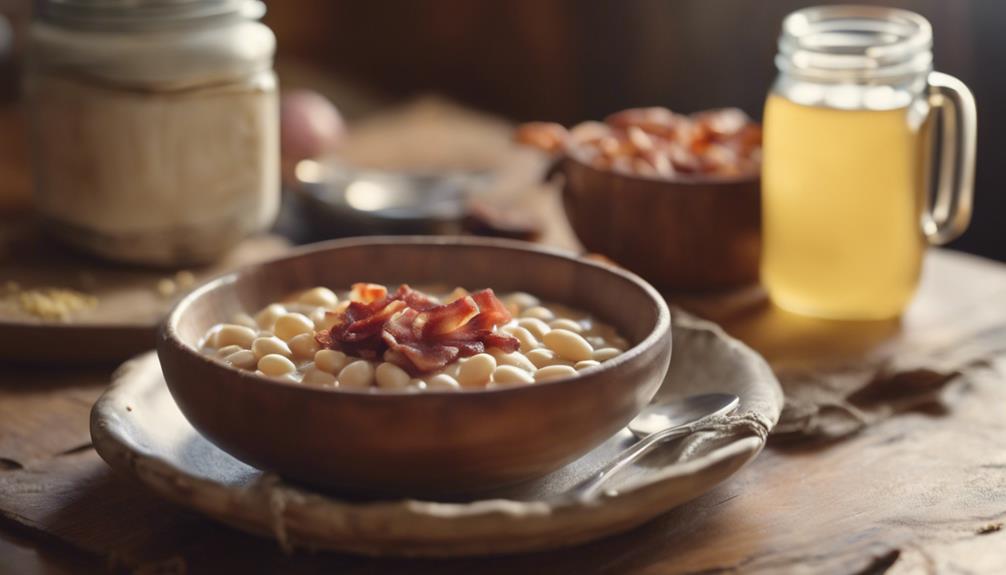
You're about to discover timeless Southern recipes that bring hearty comfort to your table.
These classic dishes embody the warmth and tradition of Southern cooking, offering a taste of nostalgia with every bite.
Get ready to savor the rich flavors and comforting goodness of Southern comfort classics.
Timeless Southern Recipes
When exploring Southern comfort classics, you'll find that butter bean recipes are a beloved staple dish known for their hearty and satisfying nature. These timeless Southern recipes make the most of ingredients like butter beans, which offer a creamy texture and mild, buttery flavor that perfectly complements traditional Southern cooking.
To create an authentic Southern butter bean dish, consider the following:
- Use High-Quality Ingredients: Opt for fresh or dried butter beans, and don't skimp on flavorful additions like bacon or ham hocks.
- Slow Cooking Techniques: Embrace slow cooking methods to allow the flavors to meld together and create a rich, comforting dish.
- Season Thoughtfully: Onions, garlic, and a touch of seasoning can elevate the humble butter bean to new heights of deliciousness.
- Serve with Cornbread: A classic accompaniment to Southern dishes, cornbread pairs perfectly with butter beans for a complete and satisfying meal.
These Southern comfort dishes are sure to become a favorite at family gatherings, offering a taste of tradition and warmth in every bite.
Hearty Comfort Dishes
For those seeking ultimate comfort in their meals, Southern classics offer a range of hearty dishes that bring warmth and satisfaction with every bite. When it comes to preparing these comforting meals, a Dutch oven can be your best friend. Set it over medium heat, and you're ready to create delicious Southern comfort dishes that will surely become family favorites.
The versatility of butter beans shines in traditional Southern recipes like stews, casseroles, and soups, adding a creamy texture and mild, buttery flavor to every dish. With a rich history deeply rooted in Southern cuisine, butter beans have stood the test of time, proving to be a beloved ingredient for generations.
Incorporating butter beans into your cooking repertoire not only pays homage to Southern culinary traditions but also brings a taste of comfort to your table. So, why not whip up a hearty butter bean stew or casserole in your Dutch oven today? Your taste buds will thank you for the cozy Southern goodness that awaits.
Meat Additions and Enhancements
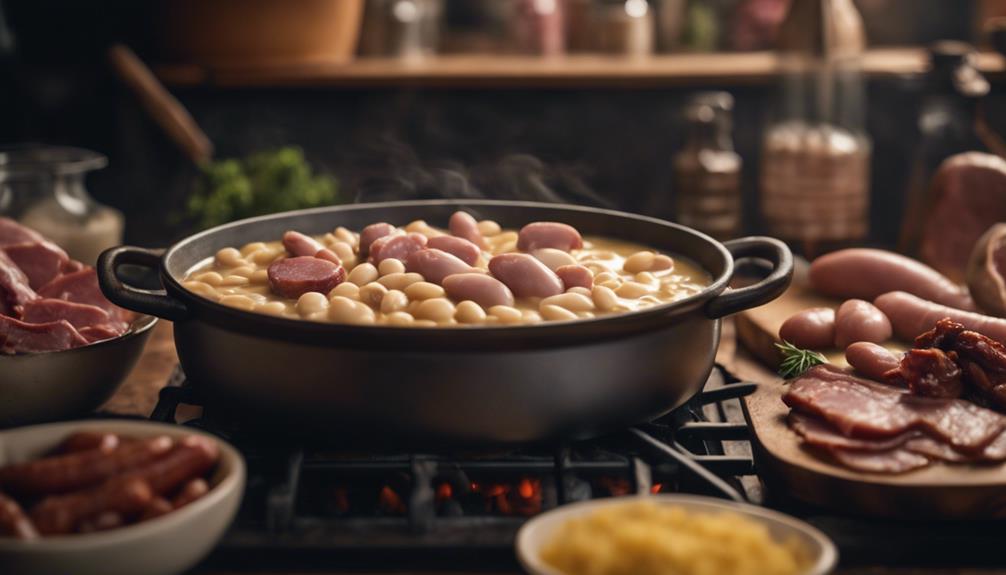
Enhance the flavor and richness of your butter bean recipe by incorporating bacon or ham into the dish. These meat additions not only add depth but also infuse the beans with a savory and smoky essence that elevates the overall taste of the dish.
To make the most of these meat additions, consider the following:
- Bacon: Fry the bacon until crispy, then crumble it into the beans for a burst of salty goodness.
- Ham: Boil the ham hocks alongside the beans to infuse the broth with a rich, meaty flavor.
- Leftover Ham: Utilize any leftover ham by adding it towards the end of cooking to retain its tenderness and taste.
- Butter: If you want to enhance the richness further, reduce the amount of butter needed to add a velvety finish to the beans.
Butter and Oil Options
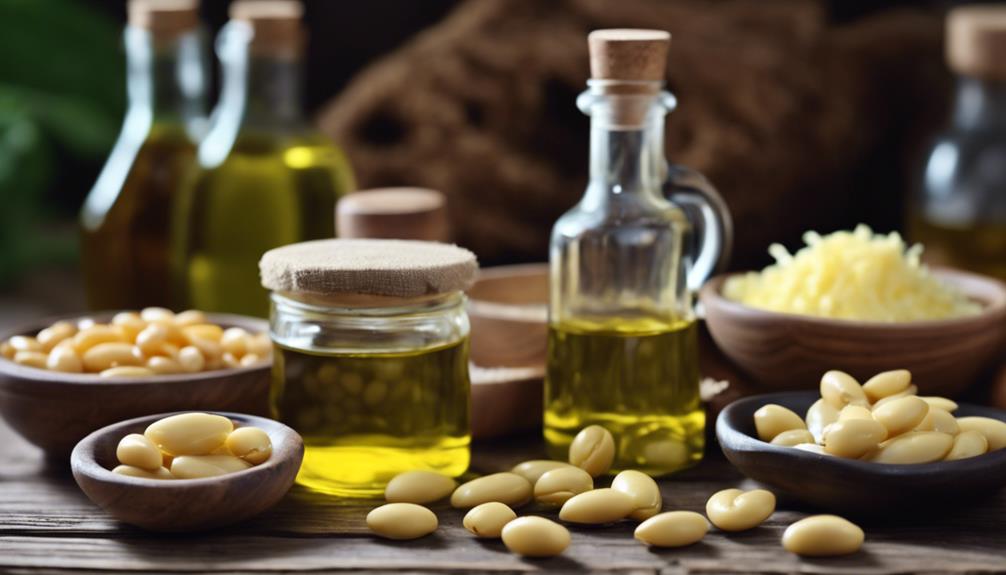
Consider incorporating butter or oil into your butter bean recipe to enhance its flavor and creaminess.
While adding butter isn't a strict requirement, it can greatly improve the overall taste and texture of your dish. If you prefer a dairy-free option or just want to experiment, using oil as a substitute can also achieve that desired creaminess in your beans.
To make this recipe even more indulgent, you may need to add a tablespoon or two of fat per pound of beans during the cooking process. This addition can infuse a rich flavor into the beans, especially when incorporated midway through cooking.
Don't be afraid to try different types of fats to see which one complements your butter beans the best. By choosing the right butter or oil for your recipe, you can elevate the flavors and create a truly satisfying dish.
Leftover Handling and Reheating
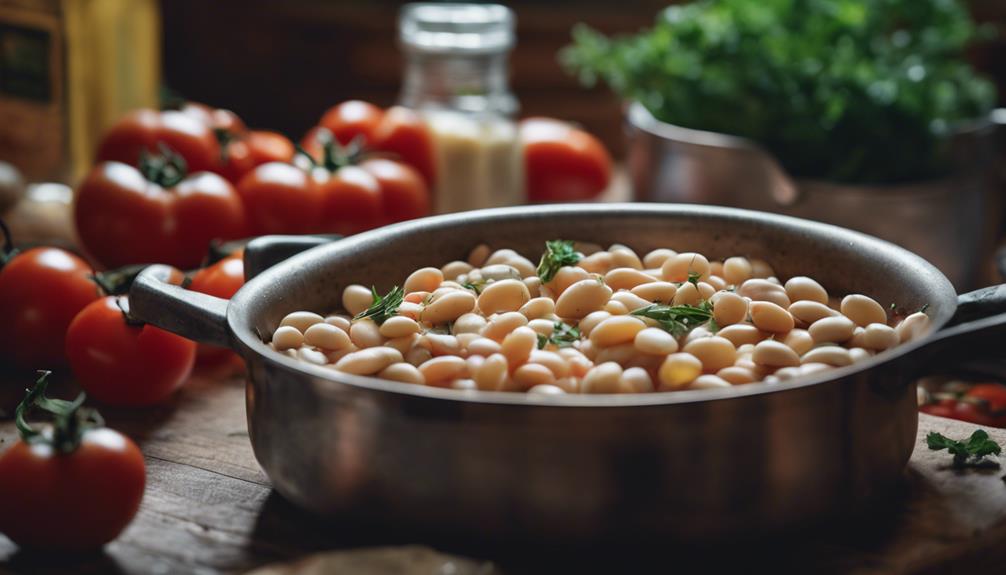
Store your cooked butter beans in an airtight container in the refrigerator for 3-4 days. When dealing with leftovers, proper handling and reheating techniques can help maintain the delicious taste and texture of your butter beans.
Here are some essential tips to make the most of your leftovers:
- Freezing Options: You can freeze cooked butter beans for up to 3 months for future use.
- Thawing Process: Thaw frozen butter beans in the refrigerator before reheating to preserve texture.
- Reheating Methods: Reheat butter beans in the microwave or on the stovetop until thoroughly heated.
- Assessing Consistency: Avoid adding water immediately when reheating butter beans; assess consistency as they heat up.
Frequently Asked Questions
Should I Soak Butter Beans Before Cooking?
You don't have to soak butter beans before cooking, but a quick 30-minute soak can help. It's optional, depending on your preference. Soaking may reduce cooking time and improve texture in some recipes, ensuring even tenderness.
Are Butter Beans Good for Your Heart?
Butter beans are like tiny heart superheroes in a pod. They're packed with fiber, potassium, folate, and magnesium—all working together to support your heart health and keep it ticking strong.
Is There a Difference Between Butter Beans and Lima Beans?
Yes, there isn't a difference between butter beans and lima beans. They're the same type of bean, just with varying names based on size. Enjoy their creamy texture and buttery taste in a variety of dishes!
What Is the American Version of Butter Beans?
In the US, butter beans are the American version of lima beans. These creamy legumes, often used in Southern cooking, offer a mild, buttery taste. So, when looking for butter beans, know you're getting a true Southern favorite!
Conclusion
To sum up, whether you choose butter beans or lima beans, the hearty and comforting flavors in this recipe will satisfy your cravings.
From the rich and creamy texture to the savory seasonings, each bite will transport you to a Southern kitchen.
So go ahead, whip up a batch of this classic dish and enjoy the warmth and nostalgia it brings to your table. It's a simple yet delicious way to experience true Southern comfort.
Sunny’s articles radiate enthusiasm, much like her sunny disposition. As our resident “Butter Geek”, she delves deep into the latest butter trends, ensuring our readers are always in the know. Beyond her writing, Sunny’s passion lies in exploring vegan butter alternatives and hosting butter-tasting soirées.
Recipes & Culinary Uses
Playtime Fun: Best Butter Slime Recipe for Kids!
Are you ready to create the best butter slime for your kids?

Ready to create the best butter slime for your kids? Mix white glue and shaving cream, then add Crayola Model Magic clay for texture. Knead the ingredients until smooth and adjust with more clay if needed. This slime is perfect for sensory play, boosting fine motor skills, and offering stress relief. Get creative by hiding treasures in the slime or making a slime volcano. Enhance tactile exploration and cognitive development with this fun activity. Discover the endless playtime possibilities and benefits of butter slime that will keep your kids entertained and engaged for hours!
Key Takeaways
- Use white glue, shaving cream, and Model Magic clay for fluffy and buttery texture.
- Follow 1/2 cup glue, 1/2 cup shaving cream, then slowly add clay.
- Knead until smooth consistency, adjust with more clay if needed.
- Store in an airtight container to maintain texture and prevent drying out.
- Enjoy sensory play, creativity, and stress relief with safe and entertaining butter slime.
Butter Slime Ingredients
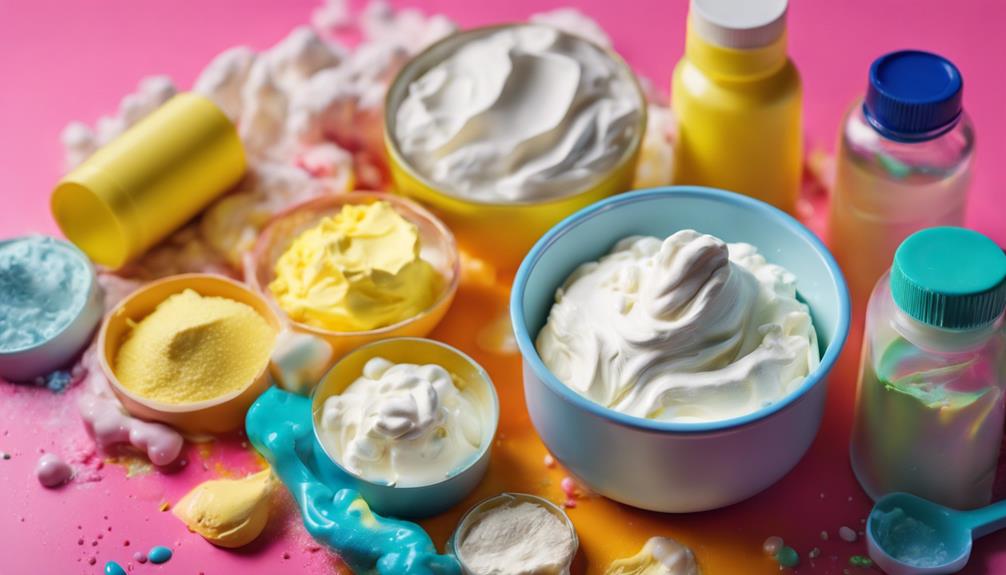
You'll need specific ingredients to create the perfect batch of butter slime for your kids. Start by gathering a cup of white school glue, a cup of Elmer's glue, baking soda, shaving cream, Crayola Model Magic clay, food coloring, lotion, and an airtight container for storage.
The white school glue, also known as PVA glue, forms the base of the slime. Shaving cream adds fluffiness and volume, while the Model Magic clay is essential for achieving that signature buttery texture. Food coloring allows for customization, and lotion can be added for extra stretchiness and softness.
Properly storing your butter slime in an airtight container will help maintain its texture and prevent it from drying out. These specific ingredients, when combined in the right proportions, will result in a delightful batch of butter slime that your kids will love playing with for hours.
How to Make Butter Slime
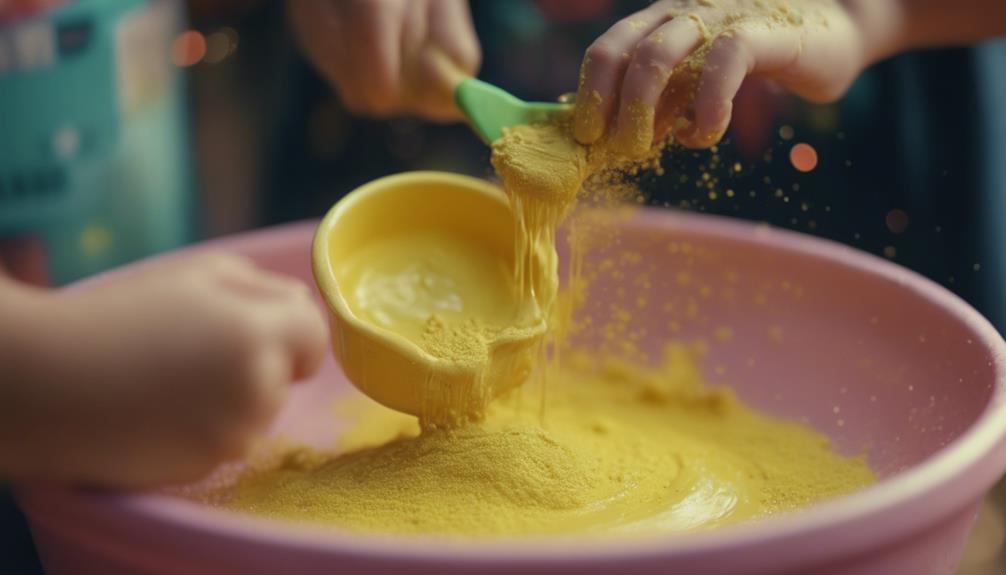
To create butter slime, begin by mixing together the glue and shaving cream in a bowl. Then, add the desired amount of clay to enhance the texture and stretchiness of the slime. Here's a simple guide to help you make your own butter slime:
| Ingredients | Amount |
|---|---|
| White Glue | 1/2 Cup |
| Shaving Cream | 1/2 Cup |
| Model Magic Clay | As needed |
First, pour the white glue and shaving cream into a mixing bowl. Mix them thoroughly until well combined. Next, slowly incorporate the Model Magic clay into the mixture. Knead the slime with your hands until you achieve a smooth and spreadable consistency. If the slime is too sticky, you can add a bit more clay. Once you've reached the desired texture, your butter slime is ready for playtime fun with the kids! Enjoy the process of making and playing with this delightful sensory material.
Benefits of Butter Slime
Butter slime offers children a sensory-rich and therapeutic play experience, promoting creativity and fine motor skill development. Engaging in sensory play with butter slime can help children explore different textures, colors, and scents, stimulating their senses and fostering creativity.
The squishy and stretchy nature of butter slime provides stress relief for children, offering a therapeutic outlet for them to relax and unwind. Manipulating butter slime also helps enhance fine motor skills as kids pinch, squeeze, and mold the slime, improving their hand-eye coordination and dexterity.
Moreover, butter slime is a safe activity suitable for kids of all ages, providing hours of entertainment and learning. By storing butter slime properly in an airtight container, you can guarantee its longevity for continued play over several days.
Playtime Ideas With Butter Slime

For an engaging and creative playtime experience with butter slime, consider trying out these fun and educational activities with your child. Using butter slime in play can be a great way to have fun and learn simultaneously. Check out the table below for some exciting ideas to explore with your child:
| Playtime Ideas | Benefits | Keywords |
|---|---|---|
| Hide treasures in slime | Encourages sensory play and imaginative exploration | play,fun,sensory play,imagination |
| Spell out names with slime | Enhances fine motor skills and promotes letter recognition | using,butter slime recipe,fine motor skills |
| Create a slime volcano | Hands-on science experiment teaching about chemical reactions | creative,science experiment |
| Slime garden activity | Fosters creativity and imagination with the addition of plants and figurines | fun,kids activities,imagination |
| Self-portrait with slime | Develops perceptual awareness in children through a sensory play activity | sensory play,creative |
These activities not only provide entertainment but also offer a chance for your child to learn and grow through play.
Sensory Activities With Butter Slime

Engage your child in sensory activities with butter slime to enhance their tactile exploration and foster creativity. Kids love the smooth and spreadable texture of butter slime, making it perfect for sensory play. This type of slime offers a unique sensory experience, encouraging children to touch and manipulate it, stimulating their fine motor skills development.
By incorporating butter slime into playtime, you can create a calming and engaging sensory play session that promotes hands-on learning and cognitive development. These sensory activities not only provide a fun and interactive way for kids to play but also help in boosting their cognitive skills through sensory exploration.
Let your child immerse themselves in the world of sensory play with butter slime, where they can explore, create, and learn in a tactile and exciting manner. Make playtime fun and educational with sensory activities that spark imagination and creativity.
Frequently Asked Questions
How to Make Butter Slime for Kids?
To make butter slime for kids, you'll need white school glue, shaving cream, cornstarch, lotion, and Model Magic clay for stretchiness. Customize with colors, glitter, or sequins. Encourage fine motor skills and creativity through fun sensory play.
How to Make Butter Slime With 3 Ingredients?
To make butter slime with 3 ingredients, grab white glue, shaving cream, and cornstarch. Mix them together for a smooth, cloud-like texture. Remember, simplicity is key – less is more when it comes to creating this fun sensory play material!
What Is the Best Activator for Butter Slime?
To make the best butter slime, experiment with Borax, saline solution, or liquid starch as activators. Find what works for you, whether it's Borax for effectiveness, saline for gentleness, or liquid starch for good results.
How to Make Butter Slime With 2 Ingredients?
Mix hair conditioner and cornstarch in a bowl. Knead the soft dough until smooth. Add sparkles for extra flair. Immerse yourself in this easy, no-cook activity with your kids for a sensory delight that's bound to be a hit!
Conclusion
Now that you've got your butter slime ready, get ready for hours of squishy, stretchy fun!
Let your imagination run wild as you mold and shape this creamy concoction.
Remember, the possibilities are as endless as the buttery swirls in your slime.
So go ahead, immerse yourself and let your creativity flow like a river of melted butter!
Sunny’s articles radiate enthusiasm, much like her sunny disposition. As our resident “Butter Geek”, she delves deep into the latest butter trends, ensuring our readers are always in the know. Beyond her writing, Sunny’s passion lies in exploring vegan butter alternatives and hosting butter-tasting soirées.
Recipes & Culinary Uses
Cookie Mastery: Best Recipe for Peanut Butter Cookies!
Fulfill your cookie cravings with the ultimate peanut butter cookies recipe that promises a decadent symphony of flavors – you won't want to miss out!
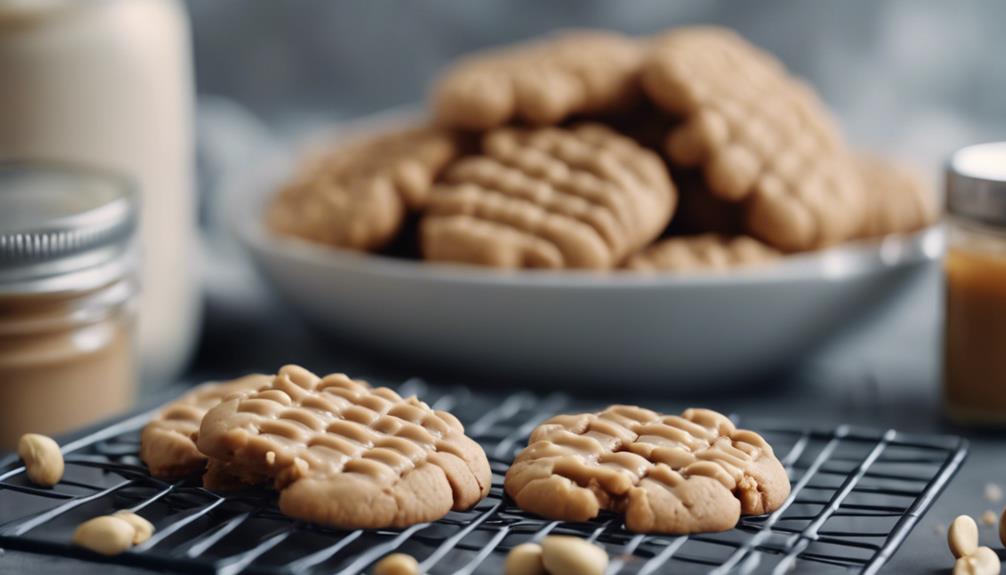
Get ready for the ultimate peanut butter cookies! Combine peanut butter, brown sugar, egg, and baking soda. Mix in chocolate chips and bake at 350°F. Enjoy a soft, chewy treat with a golden brown color. The robust peanut butter taste, sweet brown sugar, and rich chocolate chips create a decadent symphony of flavors. Each cookie provides 245 calories, with a balance of carbohydrates, protein, and fat. Pair with milk or coffee for an enhanced experience. Stay tuned for more serving suggestions and detailed reviews to keep your cookie cravings satisfied.
Key Takeaways
- Soft and chewy texture with golden brown color for irresistible appeal.
- Robust peanut butter taste complemented by sweet brown sugar.
- Decadent chocolate chips offer bursts of rich flavor.
- Thick cookies with crisp edges and soft centers for a delightful mouthfeel.
- Easy to make, perfect for parties, and pairs well with milk or coffee.
Recipe Ingredients and Preparation
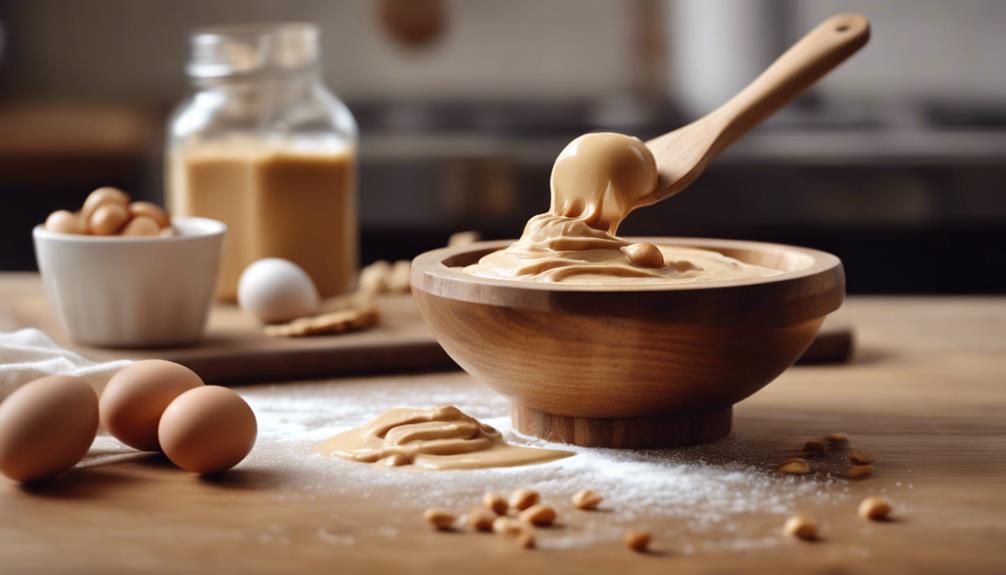
To make these delicious peanut butter cookies, gather creamy peanut butter, brown sugar, a large egg, baking soda, and chocolate chips.
Start by mixing the peanut butter, brown sugar, egg, and baking soda until well combined.
Then, gently fold in the chocolate chips to ensure uniform distribution of the sweet morsels throughout the dough.
Roll the dough into balls and place them on a baking sheet lined with parchment paper.
Bake the cookies at 350°F for 10-12 minutes until they're soft, thick, and golden brown.
As they bake, the aroma of peanut butter and chocolate will fill your kitchen, making it hard to resist peeking into the oven.
Once done, allow the cookies to cool slightly before indulging in their rich peanut butter taste, sweetness from the brown sugar, and bursts of flavor from the chocolate chips.
These peanut butter cookies are the perfect treat for any occasion, offering a satisfying blend of flavors in every bite.
Texture and Appearance Details
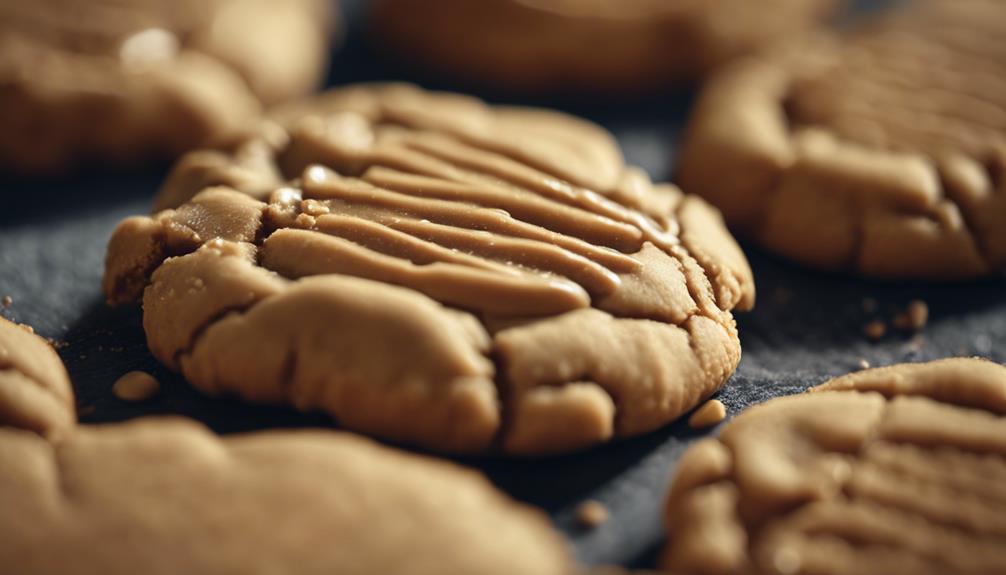
The soft and chewy texture of these peanut butter cookies, coupled with their golden brown color and delightful chocolate chip accents, make them a visually appealing and irresistible treat. As you bite into these cookies, you'll experience a satisfying thickness that offers a substantial chewiness, creating a delightful mouthfeel. The golden brown hue of the cookies, with crisp edges and a soft center, invites you to indulge in their homemade goodness. Chocolate chips scattered throughout each cookie not only enhance the flavor but also provide a pop of visual interest, adding to the overall allure of these treats. Additionally, the aroma that fills your kitchen as these cookies bake is simply irresistible, with the rich scent of peanut butter enveloping your senses. Below is a table summarizing the key texture and appearance details of these peanut butter cookies:
| Texture | Appearance | Additions |
|---|---|---|
| Soft | Golden brown | Chocolate chips |
| Chewy | Crisp edges | |
| Substantial | Soft center |
Flavor Profile Description
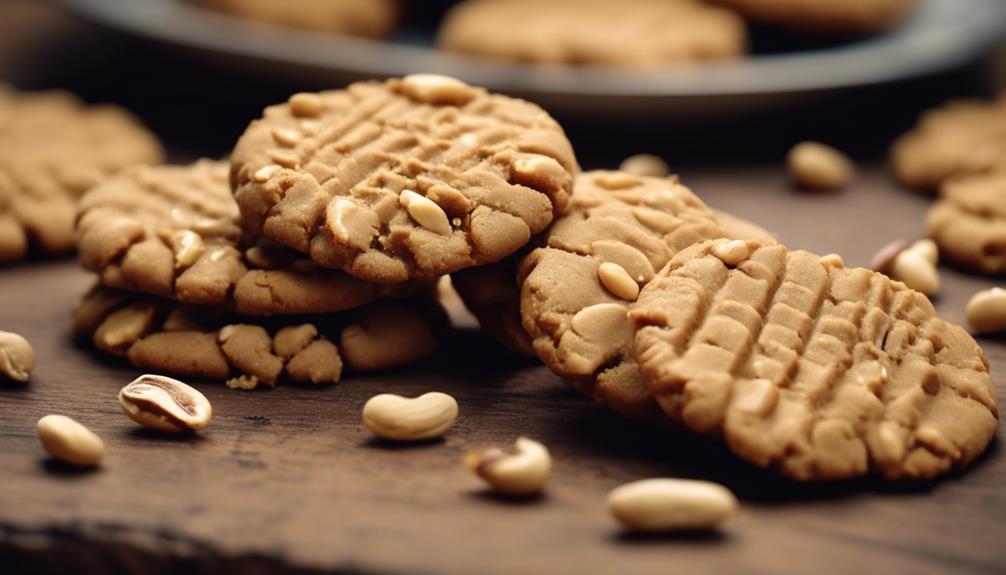
Peanut butter takes center stage in every decadent bite of these cookies, enchanting your taste buds with its rich and nutty essence. The flavor profile of these peanut butter cookies is a delightful symphony of tastes that will leave you craving more.
Here's why:
- Peanut Butter Taste: The unmistakable flavor of creamy peanut butter is the star of these cookies, providing a robust and nutty undertone that lingers with each bite.
- Brown Sugar Sweetness: The addition of brown sugar adds a perfect touch of sweetness that complements the peanut butter taste, creating a well-balanced and indulgent flavor profile.
- Chocolate Chips: The chocolate chips scattered throughout the cookie dough offer bursts of rich and decadent flavor, contrasting beautifully with the nuttiness of the peanut butter and adding an extra layer of deliciousness to each cookie.
Together, these elements harmonize to create a flavor profile that's both comforting and irresistible, making these peanut butter cookies a favorite treat for any occasion.
Nutrition Information Breakdown

Shifting from the flavor profile description, let's now take a closer look at the nutrition information breakdown of these delectable peanut butter cookies. Each serving of these cookies contains 245 calories, making them a reasonable treat for your sweet cravings.
The 27g of carbohydrates offer a delightful sweetness, while the 4g of protein in a single cookie contributes to a balanced snack option. With 13g of fat per cookie, these treats provide a rich and flavorful experience that has garnered rave reviews.
To bake these scrumptious cookies, make sure you use a cookie sheet lined with parchment paper to prevent sticking. The recipe calls for unsalted butter to control the sodium content, which amounts to 152mg per serving.
It's important to enjoy these cookies in moderation due to their calorie and fat content. However, their protein and carbohydrate balance makes them a satisfying indulgence for any cookie lover.
Serving Suggestions and Reviews
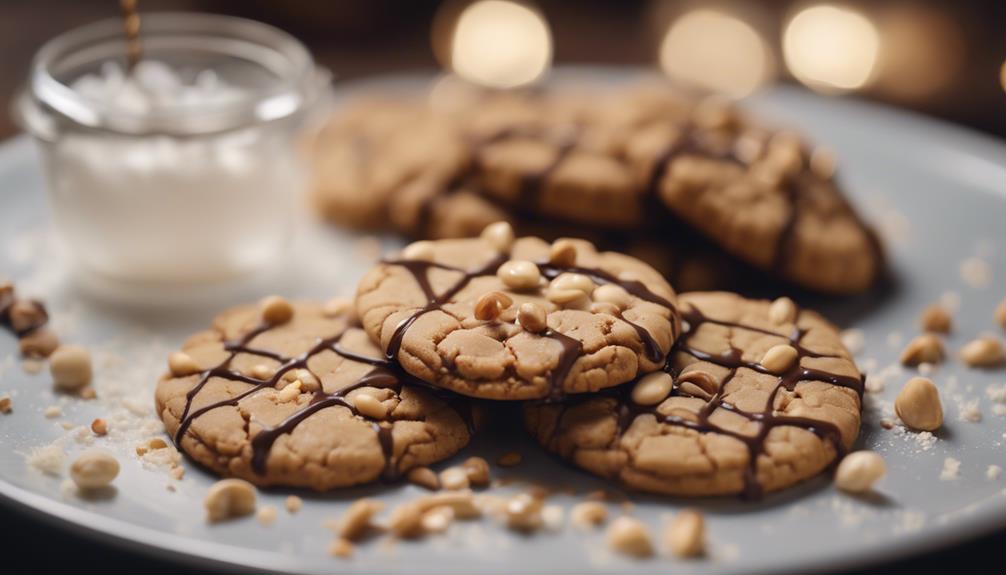
Enhance your cookie-eating experience by pairing these delightful peanut butter cookies with a glass of milk or a cup of coffee. Reviewers have expressed positive feedback on the cookies' taste and texture, with many delighted by the recipe's success. Taking the time to bake these cookies will be well worth it based on the glowing reviews and high ratings they've received.
Here are some things reviewers liked about this recipe:
- The cookies' soft and thick texture that makes them perfect for parties or gatherings.
- The cookies' ability to pair exceptionally well with a glass of milk or a cup of coffee, enhancing the overall flavor experience.
- The ease of storing the cookies for a few days without compromising on freshness, allowing for continued enjoyment over time.
Frequently Asked Questions
Is It Better to Use Butter or Shortening in Peanut Butter Cookies?
For peanut butter cookies, use butter for flavor and richness, or shortening to maintain shape. Butter yields softer texture, while shortening gives a firmer bite. The choice depends on your preference for taste and texture.
Why Are My Peanut Butter Cookies Always Hard?
Overbaking leads to hard cookies. Guarantee precise baking time. Too much flour or insufficient fat causes dry dough and hardness. Cream butter and sugar moderately to prevent crumbliness. Excessive mix-ins make cookies dense. Improper storage dries out cookies, making them hard.
Why Are My Peanut Butter Cookies Crumbling and Falling Apart?
Your peanut butter cookies may be crumbling due to overbaking, excess flour, insufficient fat, too much leavening agent, or inadequate mixing. Adjust baking time, ingredients, and mixing technique to achieve cookies that hold together perfectly.
What Are the Basic Ingredients for Peanut Butter Cookies?
You need creamy peanut butter, brown sugar, egg, and baking soda for peanut butter cookies. They taste nutty and sweet, with a soft, chewy texture. Add chocolate chips for extra flavor. Just mix, bake, and enjoy these delicious treats!
Conclusion
You've mastered the art of baking with this peanut butter cookie recipe!
Did you know that Americans consume over 7 billion cookies a year?
So next time you whip up a batch of these delicious treats, know that you're contributing to that sweet statistic.
Keep baking and enjoy every bite of these irresistible peanut butter cookies!
Sunny’s articles radiate enthusiasm, much like her sunny disposition. As our resident “Butter Geek”, she delves deep into the latest butter trends, ensuring our readers are always in the know. Beyond her writing, Sunny’s passion lies in exploring vegan butter alternatives and hosting butter-tasting soirées.
-

 Recipes & Culinary Uses4 months ago
Recipes & Culinary Uses4 months agoMake Homemade Butter from Milk at Home
-
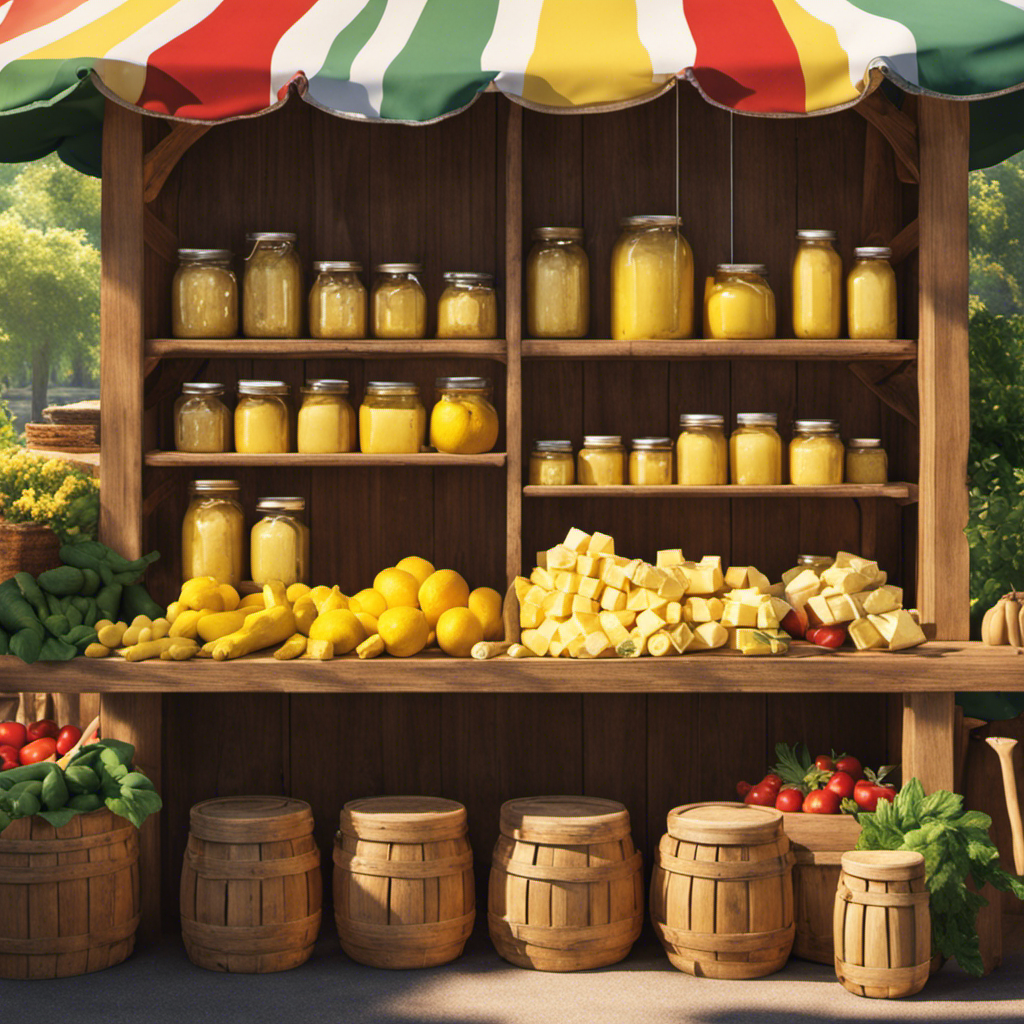
 Shopping Guides4 months ago
Shopping Guides4 months agoWhere to Buy Raw Butter
-

 Butter Tips and Tricks6 months ago
Butter Tips and Tricks6 months agoChurn Butter the Old Fashioned Way: 3 Traditional Steps
-
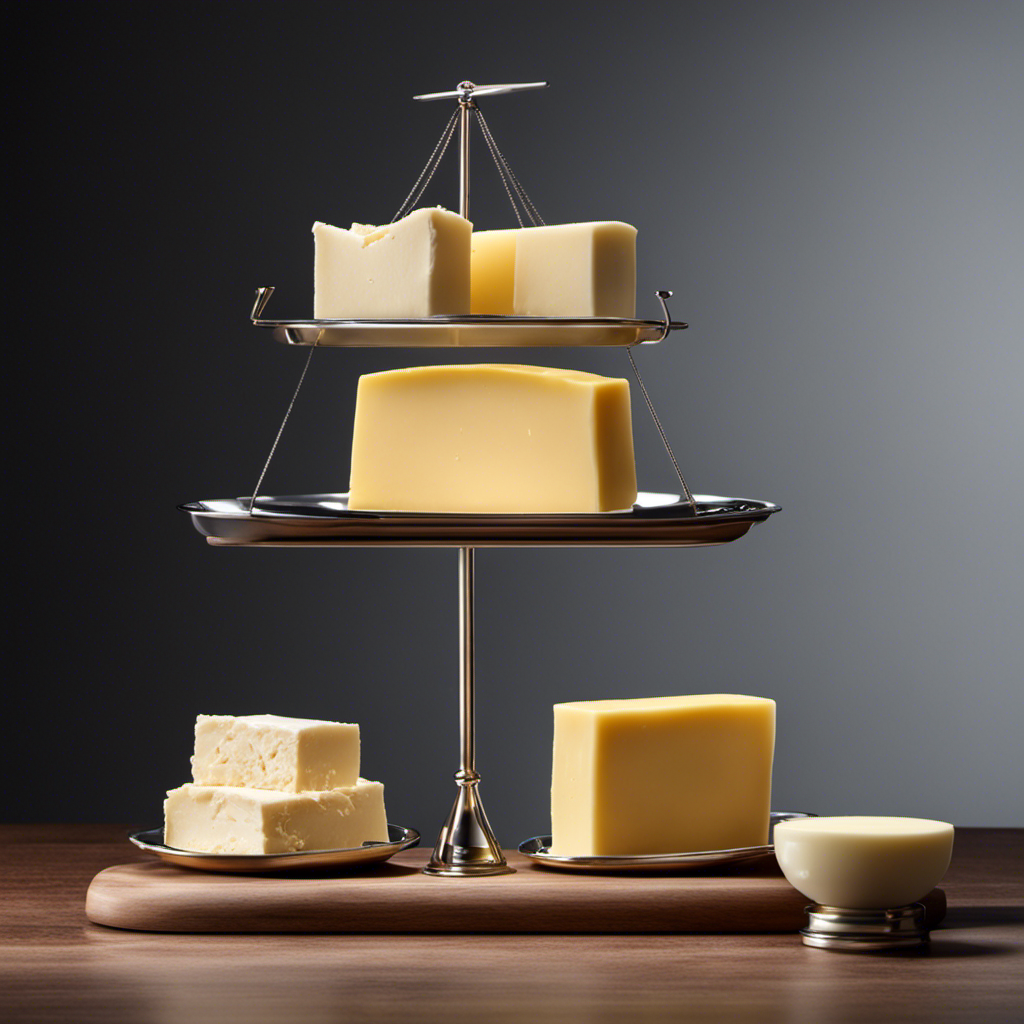
 Recipes & Culinary Uses5 months ago
Recipes & Culinary Uses5 months agoHow Many Sticks of Butter Equals a Pound: A Handy Guide
-

 Recipes & Culinary Uses4 months ago
Recipes & Culinary Uses4 months agoMake Creamy Butter From Buttermilk
-
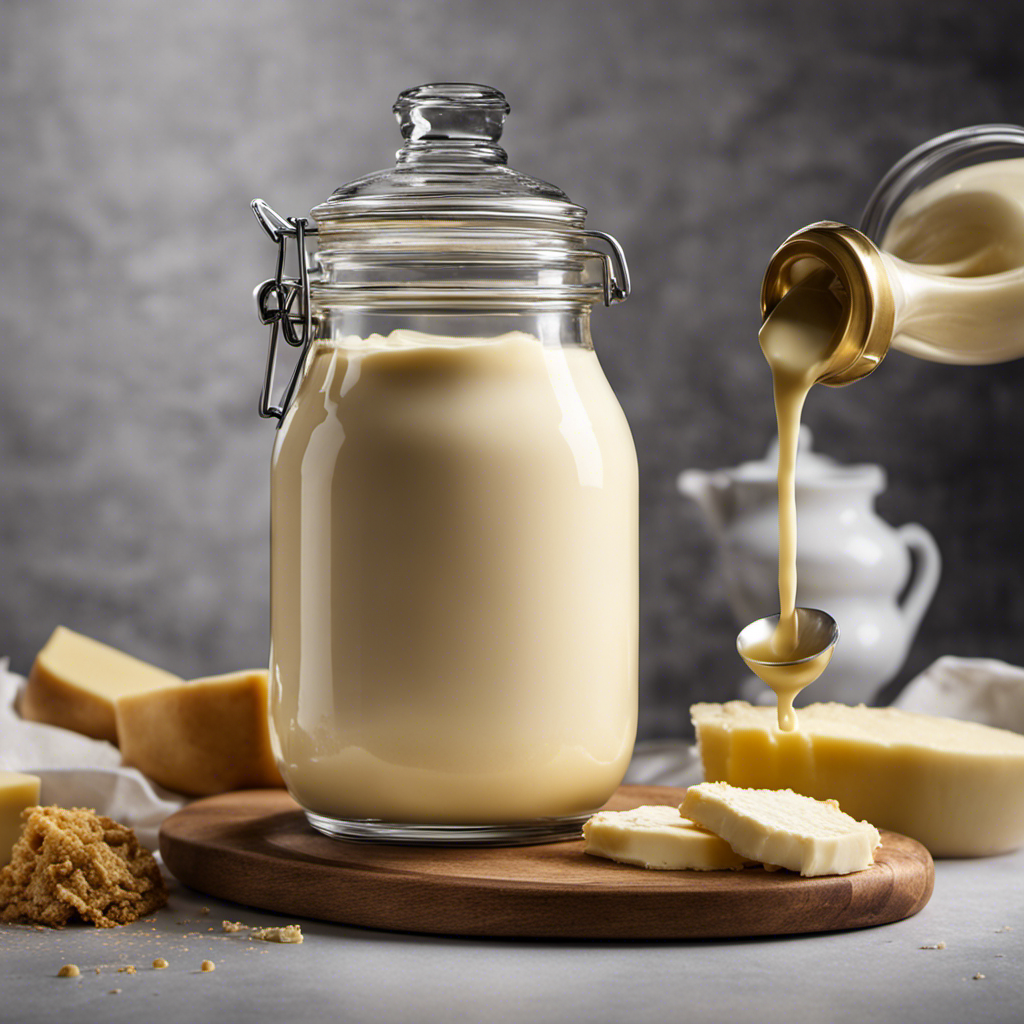
 Butter Tips and Tricks6 months ago
Butter Tips and Tricks6 months agoHow Much Heavy Cream to Make Butter: A Step-by-Step Guide
-
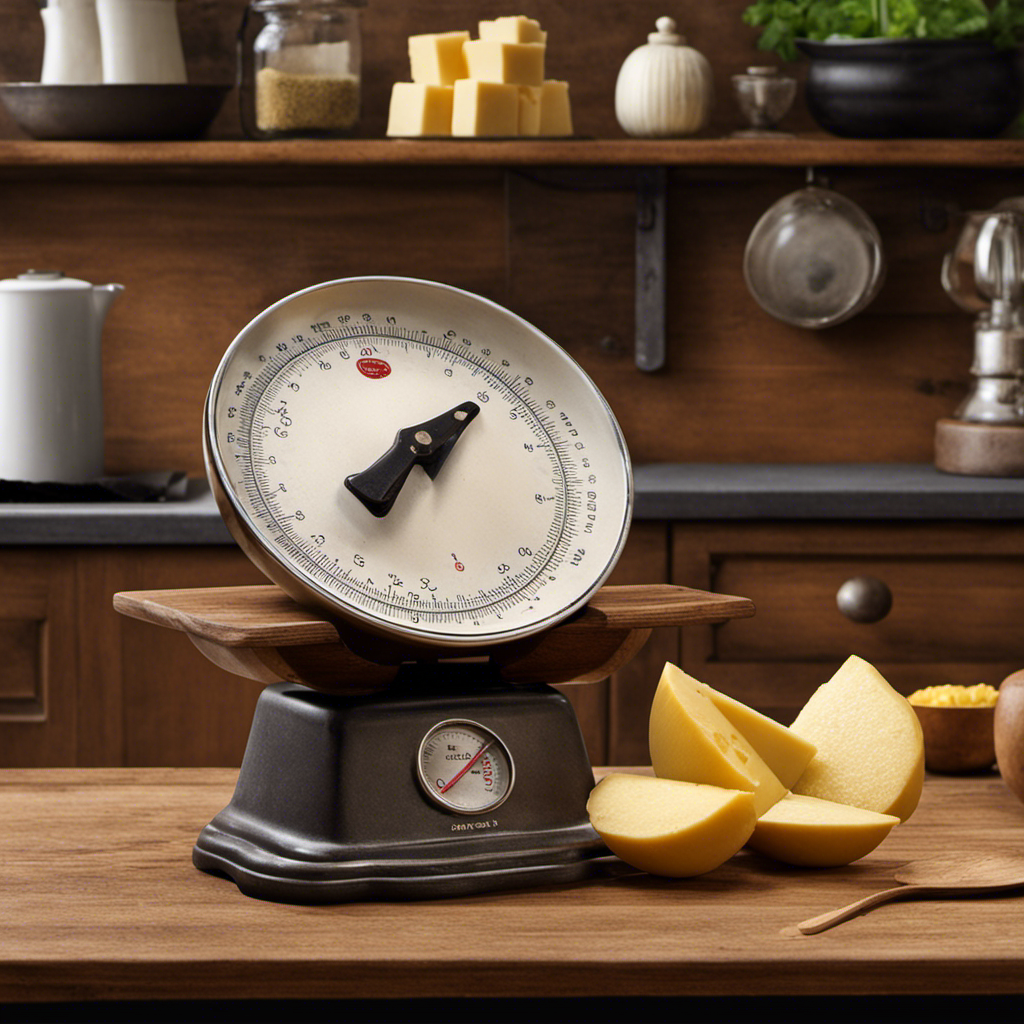
 Butter Tips and Tricks6 months ago
Butter Tips and Tricks6 months agoHow Many Sticks of Butter in 2/3 Cup: A Simple Guide
-
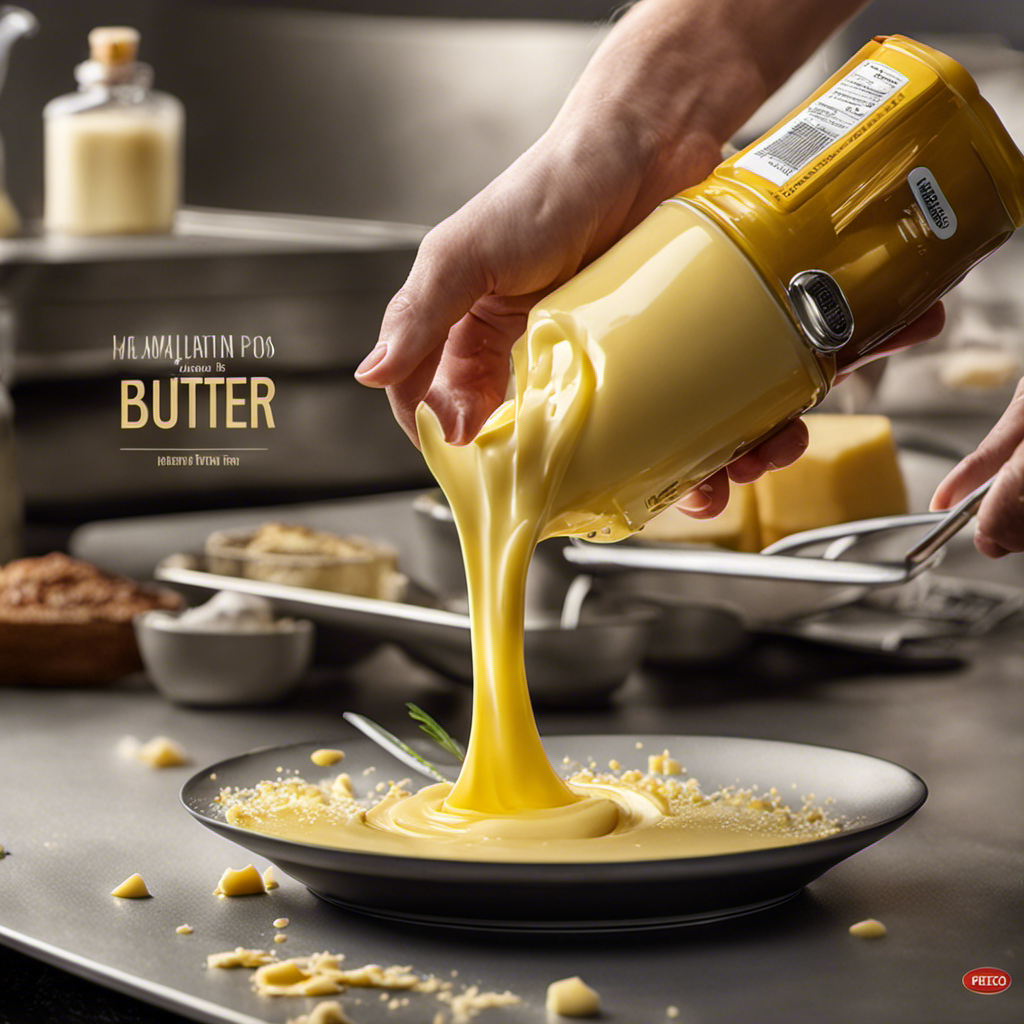
 Recipes & Culinary Uses5 months ago
Recipes & Culinary Uses5 months agoMake Your Own Homemade Spray Butter





